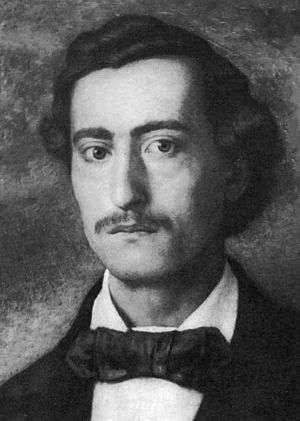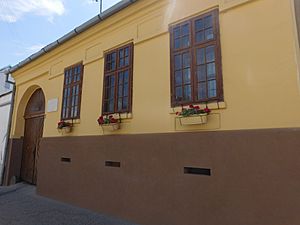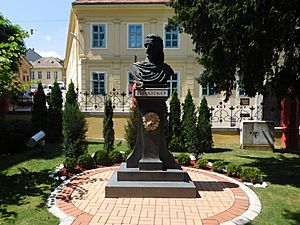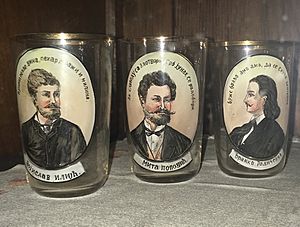Branko Radičević facts for kids
Quick facts for kids
Branko Radičević
|
|
|---|---|
 |
|
| Born | Aleksije Radičević 28 March 1824 Slavonski Brod, Austrian Empire (modern-day Croatia) |
| Died | 1 July 1853 (aged 29) Vienna, Austria-Hungary (modern-day Austria) |
| Pen name | Branko |
| Occupation | Poet |
| Nationality | Austrian |
| Education | Gymnasium of Karlovci |
| Literary movement | Romanticism |
| Notable works | Đački rastanak Kad mlidijah umreti |
Aleksije "Branko" Radičević (born March 28, 1824 – died July 1, 1853) was a famous Serbian poet. He was part of the Romanticism movement, which was a style of art and literature popular in his time.
Contents
Who Was Branko Radičević?
Branko Radičević was born in Slavonski Brod on March 15, 1824. His birth name was Aleksije, but he later changed it to Branko, a more common Serbian name. He went to high school in Sremski Karlovci, a place that inspired many of his best poems. After that, he studied in Vienna.
In 1847, Branko published his first book of poems. This book was very important and started a new period in Serbian poetry. He later went to Serbia but soon returned to Vienna to study medicine. In Vienna, he was often with other Serbian thinkers and writers. These included his friend Bogoboj Atanacković, Vuk Karadžić, Đuro Daničić, Milica Stojadinović-Srpkinja, and Petar II Petrović-Njegoš.
Branko Radičević died from tuberculosis in Vienna in 1853. In 1883, his body was moved and buried in Stražilovo.
Branko's Poetry and Language Reform
Branko Radičević was one of the first writers to use the simple language of everyday people in his poems. He tried to make his poems sound like traditional folk songs. This helped support the ideas of Vuk Karadžić, who believed that even poetry could be written in the newly changed Serbian language.
Branko was very important for Vuk Karadžić's success. He brought together many young writers and poets of his generation. They all supported the idea of changing the Serbian language to make it simpler and easier to understand.
His most famous work is Đački rastanak (The Parting of Schoolfriends). In this poem, Branko wrote about the lives of college students. Another important poem is Kad mlidijah umreti (As I Thought of Dying), which he wrote close to the end of his life.
In his poem Put (A Journey), Branko used satire to make fun of those who did not agree with Vuk Karadžić's language changes. He also wrote Bezimena (Unnamed), where he changed his writing style.
His work greatly helped Vuk Karadžić win the cultural battle to reform the Serbian language.
Branko Radičević's Lasting Impact
Branko Radičević left some poems unfinished. One important unfinished poem was 1477 lines long and had two titles: Ludi Branko (Branko the Fool) and Bezimena (Unnamed).
Branko Radičević is included in a list called The 100 most prominent Serbs. He had a big influence on later generations of Serbian poets. These included famous writers like Đura Jakšić and Miloš Crnjanski.
Sadly, a statue of Branko and a plaque on his birth house in Slavonski Brod were removed in the 1990s. There are now talks to rebuild the statue.
Many of his poems have been turned into songs.
The Branko's Award was created in 1954 to honor him. This award is given to the best book of poetry written in Serbian by authors under 30 years old.
Squares in Zemun and Sremski Karlovci are named after him. Many schools in cities like Batajnica, Novi Sad, and Banja Luka also carry his name.
Famous Works by Branko Radičević
- Kad mlidijah umreti (As I Thought of Dying)
- Tuga i opomena (Sadness and Warning)
- Đački rastanak (The Parting of Schoolfriends)
- Put (A Journey)
- Bezimena (Unnamed)
- Utopljenica
- Osveta
See also
 In Spanish: Branko Radičević para niños
In Spanish: Branko Radičević para niños




